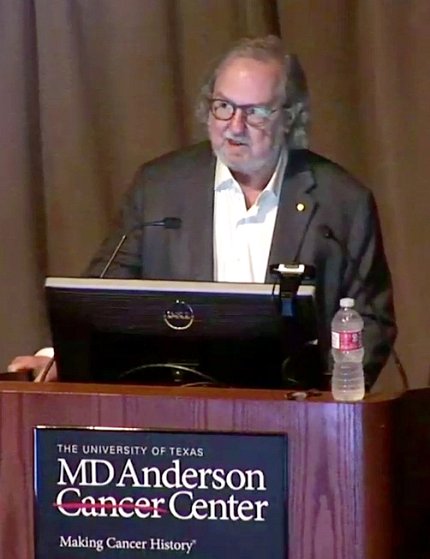Empty Hall, Full Talk
Nobelist Allison Pushes Deeper into Cancer Immunology

Never before in the history of the Wednesday Afternoon Lecture Series has a speaker in one empty room 1,400 miles from Masur Auditorium given a lecture to another empty room in Bldg. 1.
But such was the case Mar. 11 when, owing to public health concerns over the spread of COVID-19 disease, Nobel laureate (2018) Dr. Jim Allison’s lecture on “Immune Checkpoint Blockade in Cancer Therapy: Historical Perspective, New Opportunities and Prospects for Cures” became a videocast only.
“I am speaking to you from a very empty Wilson Hall,” said NIH director Dr. Francis Collins, who introduced the lecture, seen live by more than 800 online viewers. “This is an historic lecture in two ways: Our speaker, Jim Allison, is a remarkable role model of a passionate, determined, inquisitive scientist. And, we’ve never done it like this before—a virtual presentation, due to concerns about this virus.”
Collins called Allison “an interesting character, an iconoclast. One of his colleagues once observed, ‘Jim’s lab has the feel of a pirate ship.’”

Collins also divulged, “I once had the pleasure of performing a duet with [Allison], in a bar east of the Capitol.” Collins, on guitar, accompanied Allison, whose skill on the mouth harp has put him on stage with country music star Willie Nelson in the past.
“I’m sitting in an empty room,” began Allison, who is chair of the department of immunology at MD Anderson Cancer Center. He apologized for missing an opportunity to mingle with old friends at NIH. “I miss you guys.”
He then reviewed in detail the history of checkpoint blockade, focusing on two molecules, CTLA-4 and PD-1. Surprisingly, he said, they work against some tumors very well in combination, “but not just as the sum of the two.”
Importantly, the new therapies do not attack the tumor itself, but free the immune system to go after the tumor, Allison explained.
In the case of the anti-CTLA-4 antibody known as ipilimumab—which was developed from Allison’s research—the blockade of a single molecule is enough to produce “an astounding result…It is sufficient to create long-lived immunity,” Allison said.
One patient, treated 16 years ago with the antibody, is still doing fine, despite having once had melanoma with metastases to the lungs and brain.
“Another patient is 19 years out, so this is a very durable response,” said Allison. “I think these patients can be considered cured.”

But only about 20 percent of patients get this kind of response, so Allison and his colleagues are doubling down on finding other checkpoints. They are now using nivolumab for patients who fail ipilimumab, and vice versa.
“Combining these agents is at least additive,” he said. Researchers report a survival rate of about 55 percent using combination therapy at the 5-year point. “We consider this a very durable response. We believe the 10-year survival may exceed 50 percent.”
For perspective, prior to these therapies, life expectancy for patients with metastatic melanoma was only 7 months after diagnosis, Allison noted.
A common feature of the cancers for which checkpoint blockade is effective is the process of DNA defect repair, observed Allison. Anti-CTLA-4 antibodies target the CD 28 pathway, whereas anti-PD-1 antibodies affect only CD 8 cells. Monotherapy with either agent has “overlapping but quite distinct effects,” he said. “They expand different cell types.”
Allison believes there are other inhibitory molecules that may serve as potential targets in immunotherapy. In the future, he predicts more combinations of PD-1 and CTLA-4.
“Increases in median survival are what indicates efficacy,” he said. “We hope to see this in as many different cancers as we can. With diligence and rational use of data, we are expecting more curative combinations.”

One of some five people on hand for the lecture in Wilson Hall was Dr. Steve Rosenberg, chief of NCI’s Surgery Branch, another pioneer in cancer immunotherapy. After a brief Q&A with questions submitted online, Rosenberg told Allison, “I always learn something when I hear you talk. You keep going, you keep learning and you keep teaching us new things.”
Inasmuch as coffee and cookies commonly follow WALS lectures, Collins held up samples of both, inviting onlookers to enjoy virtual refreshment.
“Thank you for being the first-ever virtual WALS lecturer,” he told Allison. “I look forward to the end of this crazy pandemic and hope that you can come here again someday. Then maybe we can go off to a bar somewhere afterward and play music.”
The full talk is archived at https://videocast.nih.gov/summary.asp?live=36081&bhcp=1.
